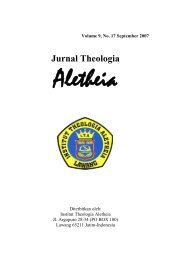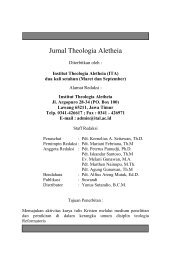download - Sekolah Tinggi Theologia Aletheia Lawang
download - Sekolah Tinggi Theologia Aletheia Lawang
download - Sekolah Tinggi Theologia Aletheia Lawang
You also want an ePaper? Increase the reach of your titles
YUMPU automatically turns print PDFs into web optimized ePapers that Google loves.
98<br />
Viewed from such a vantage point, it may be argued that the<br />
sum duty of what covenantal responsibilities entailed may be found<br />
essentially in the Shema‘. Properly understanding the Shema‘ and<br />
properly undertaking its primary praxis will lead one to inherit the life<br />
of the age to come. As the commandments are linked to Israel’s basic<br />
creed, they become the identity markers for Israel, to demarcate her<br />
as the people in covenant relation to Yahweh.<br />
The upshot of all this is that the lawyer knows his scriptures<br />
and theology very well. The reply of Jesus confirms this (v. 28) and<br />
the lawyer will gain the life of the age to come if he authentically<br />
performed what he has just enunciated. As it was mentioned earlier,<br />
the second question of the lawyer about who one’s neighbour was (v.<br />
29) might be interpreted as a genuine attempt on the lawyer’s part to<br />
be faithful to Israel’s creed. Who is the neighbour in question in order<br />
that he might be loved so that the life of the age to come is obtained?<br />
It was this second question which prompted the telling of the parable<br />
but the first question must also be kept in view.<br />
Richard Bauckham has suggested in an erudite and wellargued<br />
article that the parable was told to resolve potential<br />
conflicts in the injunctions of Torah in order to highlight that the<br />
love command should take precedence over purity laws. 139 Jesus‘<br />
interpretation of Torah would then become the real focus of the<br />
parable. That, in my opinion, is only partially correct.<br />
If the whole parable wishes to establish a halakhic point, we<br />
should expect it to make very clear the victim‘s death and not<br />
describing his condition with the ambiguous (v. 30). This<br />
word occurs only once in the NT and the evidence from other<br />
Greek literature is not clear: it could refer either to someone who is<br />
about to die or someone who appears dead but upon closer<br />
inspection actually is not. 140 Contracting impurity which<br />
139 R.J. Bauckham, ‗The Scrupulous Priest and the Good Samaritan: Jesus‘<br />
Parabolic Interpretation of the Law of Moses, NTS 44 (1998), pp. 475-89.<br />
140 Cf. Hultgren, Parables of Jesus, p. 96; Nolland, Luke 9:21 – 18:34, p. 593.<br />
See also the philological discussion in T. Kazen, Jesus and Purity Halakhah:




